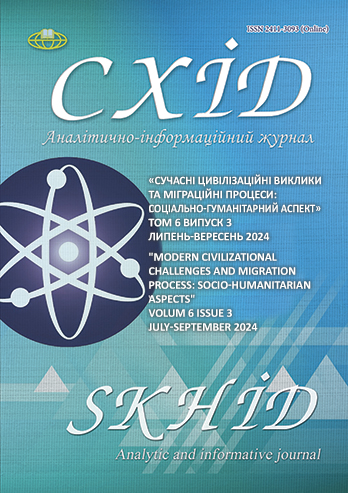Value priorities in labor behavior of Ukrainian war refugees
DOI:
https://doi.org/10.21847/2411-3093.634Keywords:
labor behavior, Ukrainian war refugees, values, institutional changes, labor mentalityAbstract
The article examines the peculiarities of the labor behavior of Ukrainians who, due to the full-scale invasion of Russia into Ukraine, left en masse to other countries to seek temporary protection and asylum. Therefore, they replenished the ranks of war refugees and, fulfilling the rules and requirements of the host countries, carry out labor activities. The peculiarities of their work behavior are considered through the prism of values, understood as the basis of individual socialization (T. Parsons). The criterion basis for the selection of values for the author's analysis was the European Social Survey of the Values of Democracy and Ways to Achieve Personal Well-being (ESS), in which Ukraine was included in 2012. At that time, the value priorities of Ukrainians in relation to work related to the level of income, job reliability, the ability to combine work and family responsibilities, to improve qualifications and the ability to take the initiative. Having chosen this scale of values as a basis and having processed a number of open statistical and scientific sources, sociological studies, the author found out how much these values have changed/transformed among war refugees who left for European countries, as of the beginning of 2023. In particular, several types of the employee's labor mentality are highlighted, which are based on the ambivalence of the elements of the national labor pattern, and the correlation of these elements with the image of the Ukrainian war refugee of the sample of 2022-2023 years is made (mostly women aged 30-60, with children, has a higher education, is a representative of the average class with high adaptability). It is shown that the prospects of Ukrainian refugees to integrate into the labor market of the host country are generally high due to their high ability to adapt to new social and economic conditions.
Downloads
References
Borisov, O. (2019). Key areas of work in EU countries that are chosen by citizens of Georgia, Belarus and Ukraine. In: Analytical report “Labor rights of migrant workers from the Eastern Partnership countries - Ukraine, Belarus, Georgia working in the informal sector in the European Union”. Retrieved from https://eap-csf.eu/wp-content/uploads/LABOR-RIGHTS-OF-MIGRANT-WORKERS-FROM-EASTERN-PARTNERSHIP-rus.pdf
Ekonomichna Pravda (2020, February 8). Zarplaty v Ukrayini vyrosly cherez milyon ukrayinskykh "za-robitchan" u Polʹshchi — NBU. Retrieved from https://www.epravda.com.ua/news/2020/02/8/656828/
ESS round 6 - 2012. Personal wellbeing, Democracy (2012). ESS Data Portal. Retrieved from https://ess-search.nsd.no/en/study/7ccf7f30-fd1a-470a-9b90-4c91b0bc7438.
Eurostat (2023, August 9): 30 June 2023: 4.07 million with temporary protection. Retrieved from https://ec.europa.eu/eurostat/en/web/products-eurostat-news/w/ddn-20230809-1.
Hofstede, G. (1994). Cultures and Organizations. Lon-don, HarperCollinsBusiness.
Malynovska, O. (ed.) (2016). Migration in Ukraine: Facts and Figures, International Organization for Migration (IOM) Mission im Ukraine. Retrieved from https://ukraine.iom.int/sites/g/files/tmzbdl1861/files/documents/ff_eng_10_10_press-1.pdf
Petrushyna, T. (2008). Sotsialno-ekonomicheskoye povedeniye naseleniya Ukrainy v usloviyakh institut-sional'nykh peremen. Kyiv, Institute of Sociology of the National Academy of Sciences of Ukraine (In Russian).
Petrushyna, T. and Slyuschinskiy, B. (2018). Value priorities and real characteristics of labour life of the population of Ukraine. Bulletin of the Mariupol State University. Series: philosophy, cultural studies, sociology, 15, 106–118.
Shulga, N. (2011). Dreyf na obochinu: dvadtsat let obshchestvennykh izmeneniy v Ukraine. Kyiv, Biznespoligraf, p.74 (In Russian).
Souza, J. (2007). The Secularity of the Peripheral Social Inequality. Plymouth, UK: Lexington Books, S. 9–35.
State Service of Ukraine on Labor Issues (2024). Unde-clared work in Ukraine is bad for everyone. Retrieved from htps://dsp.gov.ua/podolannia-nelehalnoi-zainiatosti/nezadeklarovana-pratsia-v-ukraini-pohano-dlia-vsikh/.
Survey on migration and human trafficking in Ukraine (2017). Retrieved from http://iom.org.ua/sites/default/files/migration_and_human_trafficking_in_ukraine_2017_ukr.pdf.
Synyayeva, L. (2016). Socialno-psihologschne maybut-nie ludskoho resursu v Ukraini. Economics and Or-ganization of Management, 3 (23), 109-116 (In Ukrainian).
Ukrayinske suspilstvo: monitorynh sotsialnykh zmin (2020). Rezultaty natsionalnykh shchorichnykh monitorynhovykh opytuvanʹ 1992−2020 rokiv, 7(21). Kyiv, Institute of Sociology of the National Academy of Sciences of Ukraine, S. 441−546 (In Ukrainian).
Ukrayinski-bizhentsi-viyny-za-kordonom (2022). The National Institute for Strategic Studies. Retrieved from https://niss.gov.ua/news/komentari-ekspertiv/ukrayinski-bizhentsi-viyny-za-kordonom .
Ukrinform (2023, March 1). Bilshist ukrayinskykh bizhentsiv v Polshchi znayshly robotu. Retrieved from https://www.ukrinform.ua/rubric-diaspora/3676708-bilsist-ukrainskih-bizenciv-v-polsi-znajsli-robotu-doslidzenna.html.
Vyshlinsky, H.; Mykhailyshyna, D.; Samoiliuk, M.; Tomil-ina M. (2023, September 4). Ukrainian refugees: how many are there, their intentions & return prospects. Final report. Human Capital. Retrieved from https://ces.org.ua/refugees-from-ukraine-ukr-final-report/.
Zhulyeniova, O. (2022). Vplyv viyny na tsinnisni priorytety. In: S. Dembitskyy, O.Zlobina, N.Kostenko (et al.) Ukrayinske suspilʹstvo v umovakh viyny. Kyiv: Institute of Sociology of the National Academy of Sciences of Ukraine, p. 326−336 (In Ukrainian).
Downloads
Published
How to Cite
Issue
Section
License
Copyright (c) 2024 Галина Тимофєєва

This work is licensed under a Creative Commons Attribution-NonCommercial-NoDerivatives 4.0 International License.
1. Authors bear responsibility for the accuracy of facts, quotations, numbers and names used.
2. Manuscripts are not sent back.
3. The publisher does not always agree with the authors' opinion.
4. The authors reserve the right to authorship of the work and pass the first publication right of this work to the journal under the terms of a Creative Commons Attribution-NonCommercial-NoDerivatives 4.0 International License. This license allows others to distribute (copy) the published work for non-commercial purposes, provided there is mandatory attribution to its authors and a link to the first publication in our journal.
5. The authors have the right to conclude separate supplement agreements that relate to non-exclusive work distribution in the form in which it has been published by the journal (for example, to upload the work to the online storage of the journal or publish it as part of a monograph), provided that the reference to the first publication of the work in this journal is included.

